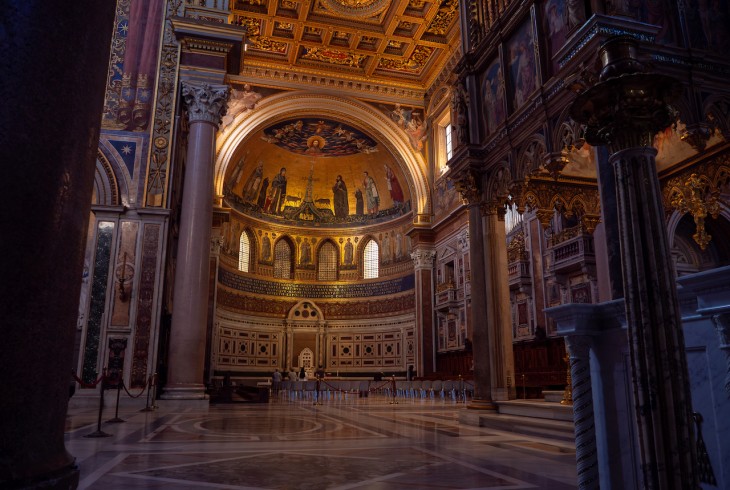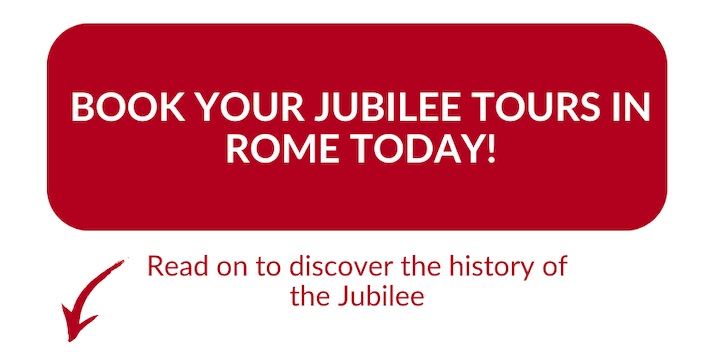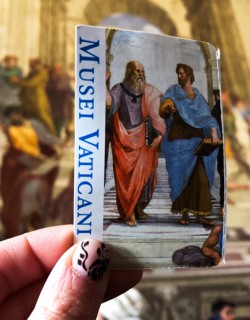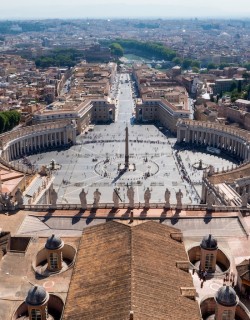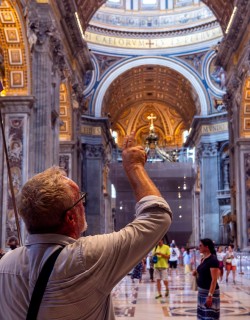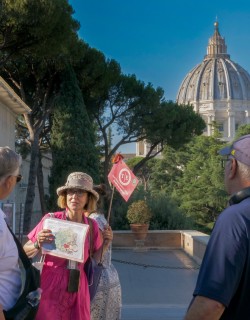The Basilica of Saint John in Lateran has an unusual dual designation. Not only does it hold the title of one of the Papal Basilicas of Rome, but it is also the city's official Cathedral. Contrary to what many Catholics might expect, St. Peter's Basilica is not Rome's Cathedral. San Giovanni in Laterano is the official seat of the Bishop of Rome, who is, of course, the Pope. It is considered the most important church in Christendom and is known as "the mother of all churches" by Catholics.
A Brief History of San Giovanni in Laterano
The origins of Saint John in Lateran lie somewhere between history and legend; however, what is certain is that it is the oldest of Rome's Papal Basilicas, first founded in the 4th century AD. The name Lateran likely derives from the name of an ancient Roman family, the Laterani, who owned the land in antiquity. While there is some disagreement amongst scholars, it's generally accepted that the first Basilica was dedicated here in either 318 or 324 AD by Pope Sylvester I, on land where the barracks of the Imperial Guard once stood. Colloquially known as the Lateran, the Basilica is, in fact, dedicated to Christ the Saviour and the Saints John the Baptist and Evangelist.
The Basilica is only part of the larger complex, including the Lateran Palaces. Indeed, the Lateran was the first home of the papacy: the Popes resided here for about a thousand years until they departed during the Avignon Papacy. During the papacy's absence, the complex fell into a sad state of disrepair, with two fires seriously damaging the palaces and Basilica. So, when the papacy returned to Rome, they decided to move to the Vatican at the end of the 14th century.
The Basilica as we see it today is the result of a major restoration in the 17th century, commissioned by Pope Alexander VII from the renowned Baroque architect Borromini. So, what treasures should you look for when you visit this jewel in the Vatican crown?
The Top Things to See at San Giovanni in Laterano
1. The Ancient Egyptian Obelisk

Weighing a shocking 455 tons and standing 32.18 meters tall (45.70 meters with the base and cross), this is Rome's and, indeed, the world's largest standing Egyptian obelisk. This red granite behemoth was carved in Aswan in the 15th century BC. It came to Rome in the 4th century AD and once adorned the "Spina" of the Circus Maximus.
The obelisk was discovered in three pieces in the 16th century and re-erected in front of San Giovanni in Laterano in 1588.
Fun fact: The Equestrian Statue of Marcus Aurelius, which stands today on Capitoline Hill, originally stood outside the Lateran until 1588.
2: The Holy Door

San Giovanni in Laterano is one of Rome's four papal basilicas and hosts one of the city's "Holy Doors." These revered portals are a focus of pilgrimage for Catholics during Jubilee or Holy Years. During these special years, Catholics flock to the city to pass through the doors on pilgrimage. In between Holy Years, the doors are sealed and bricked up.
3. The Cenotaph of Sylvester II
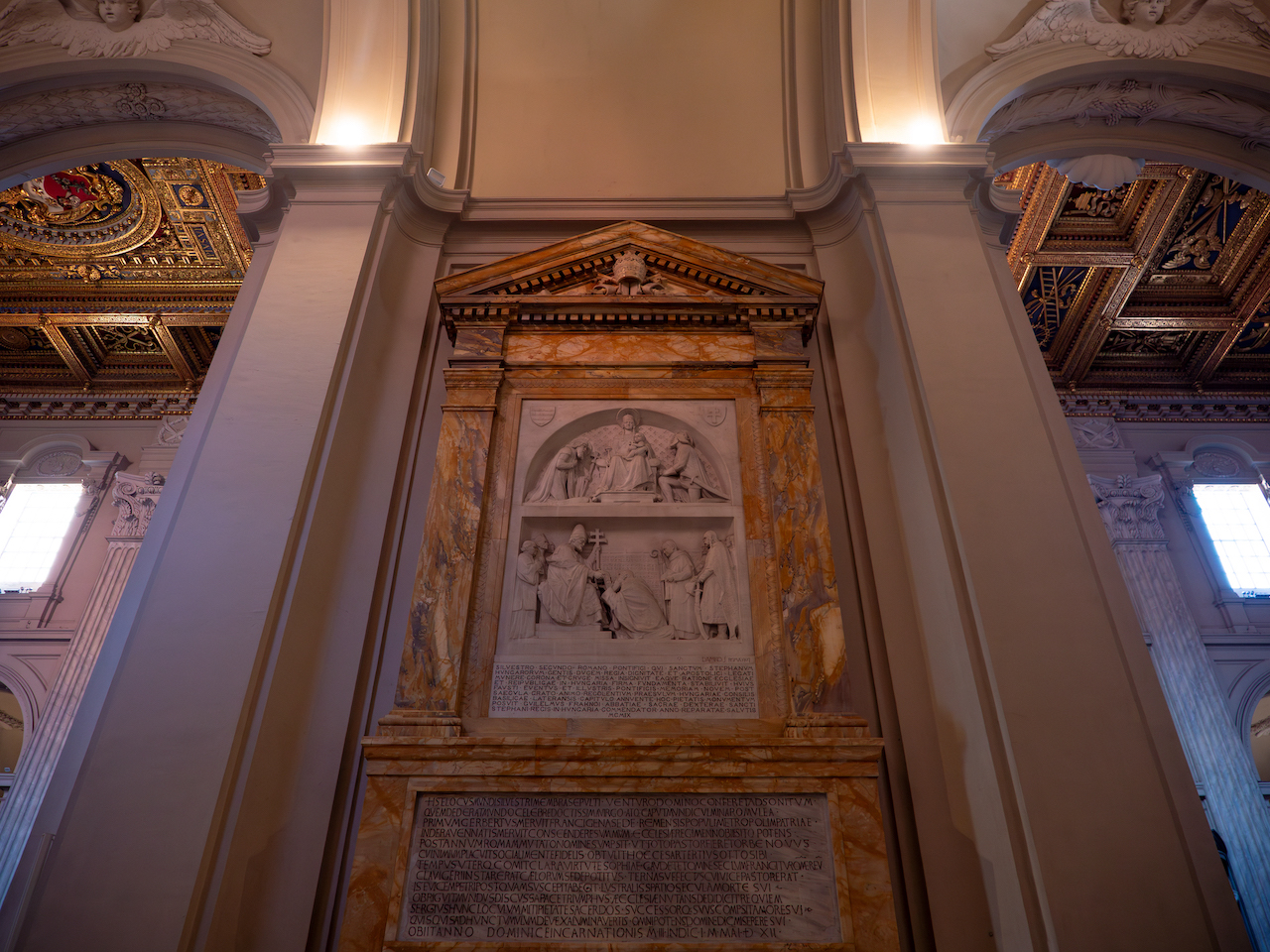
Rome is an ancient city brimming with lore and legend. This next story, however, might be among my favorites. Pope Sylvester lived in the late 11th century and was known as a magician and sorcerer. He died around 1003 AD. Sylvester was a keen student of science, and his interests have been much misinterpreted throughout history.
Popes of the Middle Ages generally went unknown, but Sylvester is unique: according to local legend," if his bones start to rattle and his grave begins to 'sweat,'" it signaled the death of the Pope. It's a hidden piece quietly observed by locals.
4. The Papal Altar & Baldacchino

The Basilica's elaborate baldacchino is a rare example of Gothic architecture in Rome. Commissioned by Pope Urban V from Giovanni di Stefano, it was completed between 1362 and 1370.
The papal altar contains an opening through which you can find a piece of wood—part of a wooden tabletop said to be the altar used by St. Peter to celebrate the Eucharist.
In the relic chamber at the top of the canopy, behind a thick golden grille, you'll find two silver-gilt reliquaries, which are said to contain the skulls of Saints Peter and Paul. The vault above the relic chamber is decorated with a golden constellation against a blue background. This is "Ultramarine Blue," one of the most expensive pigments in antiquity, obtained by grinding precious stone lapus lazuli. In the 14th century, this stone was only mined in Afganistan. Therefore, the blue pigment is more expensive per square inch than the gold gilt.
Also, check out the confessio in front of the Papal altar. Here, you'll find the bronze tomb of Pope Martin V (1417-1431). This Pope is credited with helping to rebuild Rome after the Middle Ages and bringing the Renaissance to Rome. It was during his papacy that the fine Cosmatesque floor of the nave was initially laid.
5. The Porch With Ancient Bronze Doors
The imposing main doors of the Basilica are cast from bronze. They are, in fact, much, much older than the Basilica and date back to the ancient Roman period. They were once the doors that adorned the entrance of the Curia Julia, the ancient Roman Senate House in the Roman Forum.
Pope Alexander VII ordered Borromini to transfer them to the Lateran in 1660. During the move, a Roman coin was found in the doors, which allowed archaeologists to date the reign of the emperor Domitian (AD. 81-96) nearly 2,000 years ago. The original bronze doors were too small for the Basilica, so Borromini created a new bronze frame to insert them into, decorated with eight-pointed stars, a symbol from the Pope's Chigi family crest.
Of course, the other significant set of doors that you should notice is on the far right of the porch. These are the Holy Doors, which are only open during Jubilee Years.
The statue of Constantine on the left in the narthex is also worth a look. Although heavily restored, it dates to the 4th century AD and was discovered in the Baths of Constantine.
6. The Frescos Fragments by Giotto
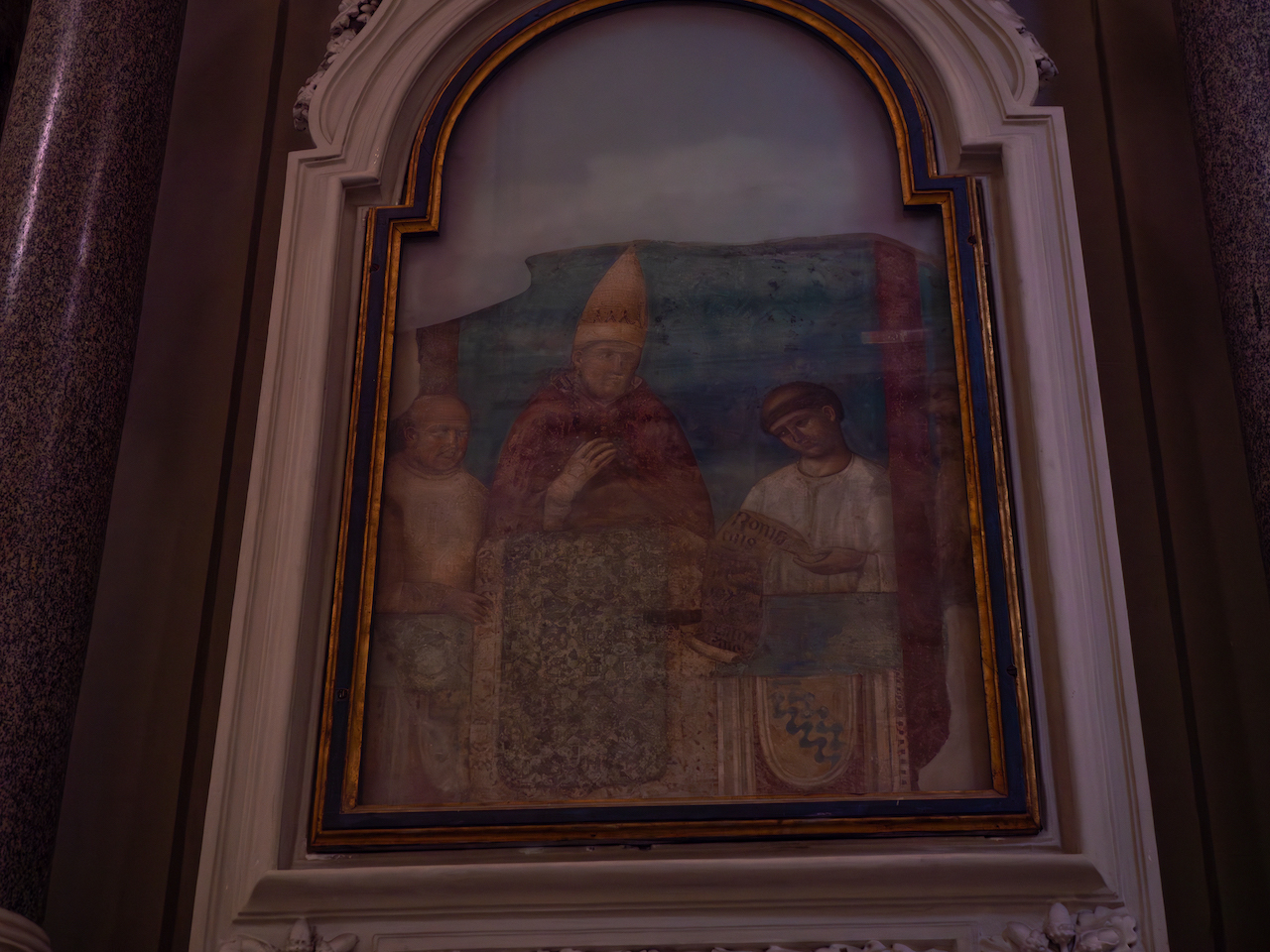
Hidden on a side aisle on one of the piers of the Basilica, you'll find a fragment of an ancient fresco protected by glass. It is the only remaining fragment of a lost fresco cycle attributed to Giotto. Look closely, and you'll see the Pope, Boniface VIII, declaring the first Christian Jubilee (Holy Year) in AD 1300.
The side aisles were completed and renovated by Borromini in the 17th century. In typical Borromini style, they are quite simple and monochrome compared to other parts of the Basilica. However, it's worth admiring the black, grey, and white floor tiles that give a trompe l'oeil effect, and you should check out the superb acoustics in the outermost aisles with its "whispering galleries."
7. Altar of the Blessed Sacrament
The Altar of the Blessed Sacrament boasts a beautiful gilded and gem-encrusted tabernacle in the shape of an octagonal temple: the work of Pompeo Targone (1575-1630).
Above it, you'll find a silver gilt reliquary containing a piece of cedar wood, purportedly a fragment of the table from the Last Supper.
They are framed by a colossal pediment held up by four ancient bronze columns. These columns certainly date to the ancient Roman period, but their exact origins remain a mystery. One theory suggests that they were initially installed in the Temple of Jupiter on the Capitoline Hill, with the bronze coming from the prows of the ships of Cleopatra's fleet, melted down after they were captured at the Battle of Actium in 31 BC.
8. The Tranquil Cloisters
The 13th-century Medieval cloisters of the Lateran are the largest in Rome. They are square cloisters measuring 36 meters (119 ft) on each side. A masterpiece of Cosmatesque art, the cloister is the work of the Vassalletto family, famous for their mastery of this style of Medieval art.
The twisting Solomonic columns and frieze with colorful ancient mosaics are enchanting and make this one of the calmest, most contemplative spaces in the city - just as it was intended to be in the Middle Ages.
A particularly curious corner of the cloister houses the "Mensura Christi," a monument of four columns with a porphyry slab embedded in the wall behind. The porphyry slab is said to be a piece of stone on which the Roman soldiers cast lots for Christ's robes, and the columns indicate His height. Rome is full of secret wonders well off the typical tourist trail.
9. The Baptistry
For many centuries, the early Church only allowed a bishop to perform the rite of baptism in a cathedral. So, the baptistry of San Giovanni in Laterno holds enormous significance. According to tradition, the emperor Constantine was baptized here. In fact, he was more likely baptized near Nicomedia in 337 AD, just before his death.
The baptistry was first founded in the latter part of Constantine's reign, around 432 AD, on the remains of the baths of the Domus Faustae, Constanine's second wife. About a century later, under Sixtus III, in 440 AD, the building was remodeled, and it has undergone many restorations and additions over the centuries. Its distinct octagonal form has informed many later baptistries throughout Italy and Europe—think of Florence's baptistry.
10. The Scala Sancta & Sancta Sanctorum
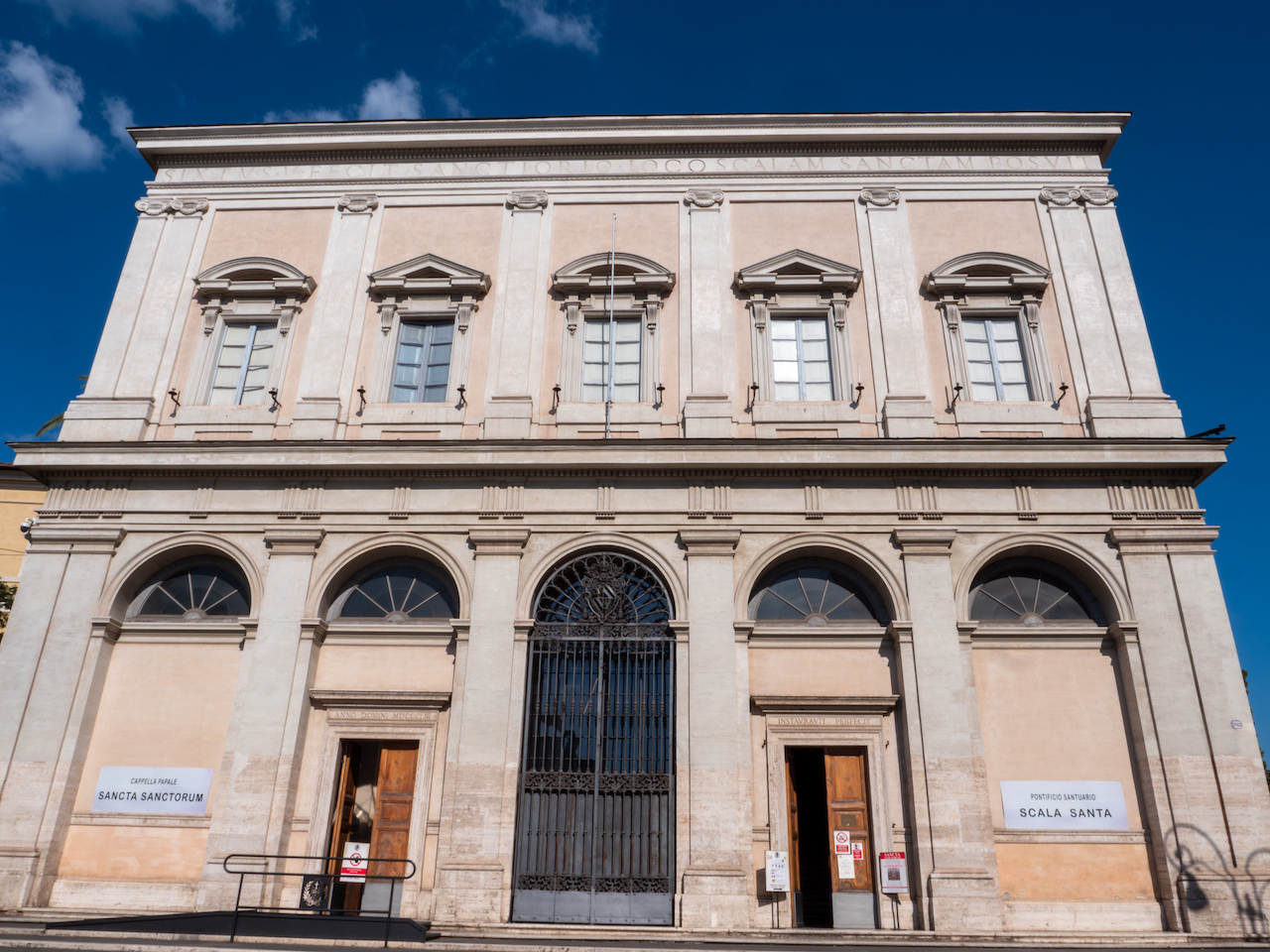
San Giovanni in Laterano is part of a much larger architectural complex, which includes the Lateran Palaces and the Scala Sancta.
The Scala Sancta (Holy Stairs) are a set of 28 marble steps that are said to have led up to the palace of Pontius Pilate in Jerusalem. These are the steps that Christ is said to have climbed to be judged by Pilate. Constantine's mother, St. Helen, returned with them from the Holy Land in the 4th century.
They hold deep significance for Catholics, who visit them on pilgrimage. Climbing these steps on your feet is prohibited; pilgrims ascend the steps on their knees.
Today, the steps are covered in walnut wood to protect them. However, on the second, eleventh, and twenty-eighth steps, you'll find little glass windows through which you can peer through. You'll see stains on the marble, which are said to be drops of Christ's blood shed during the Passion.
At the top of the steps, you'll find the Sancta Sanctorum or "Holy of Holies." Long before the construction of the Sistine Chapel, the Sancta Sanctorum was the private chapel of the popes and home to some of the most important relics in Christendom. Some relics have been lost or moved, but many remain, including an 'Acheiropoeta' (from the Greek: 'not made by human hand'). It is an ancient image of Christ Pantocrator, said to have been begun by Saint Luke but completed by angels.
For 25 years, Through Eternity have been organizing itineraries showcasing the best of Rome led by our resident expert guides. If you're planning a visit to the Eternal City this year, be sure to get in touch to help plan your perfect trip!
More From the Blog on Rome
- Everything you Need to Know About Visiting Rome
- 6 Most Ancient Churches in Rome
- How to visit the Colosseum in 2024: Tickets, Hours, and More
- 7 Things you Need to Know About the Trevi Fountain
- Visiting the Vatican Museums and St. Peter's Basilica: The Complete Guide
- 9 Things You Need to Know About the Pantheon in Rome
- 5 Reasons to Explore Italy with Through Eternity
- The Best Catacombs to Visit in Rome
